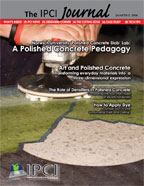How to Apply Penetrating Dye
And How NOT to Dye Surrounding Walls and Ceilings
by Joe Dew
Are your artistic abilities just a hair above your daughter’s kindergarten stick figure portraits - drawn with crayons?
Dye.
First, let me explain that there IS a difference between dyes and stains.
Dye is shipped out in powder form to be mixed with a base before use. The two types are solvent-based or water-based. The most popular, for now anyways, is solvent-based, and the solvent used is acetone.
So, why is dye not shipped pre-mixed?
1. It’s easy to shake so it will dissolve all colorant particles.
2. You can easily record the mix date and color on the can using a magic marker.
3. Your can of dye stays contained until needed, making it easier to transport and store.
Mix your dye 24 hours in advance.
Have you noticed a few words used so far like ‘Steel Can’ or ‘Acetone Resistant Sprayer’? Ok, just one more chemistry lesson. Acetone is an emulsifier. Emulsifiers are designed to breakdown or dissolve petroleum based products, including plastic and rubber. Hence the reason acetone is stored in steel containers.
Now, I need you to grab a hold of this one.
Generally, dye is applied after the 400 grit resin step, but depending on the final shine and the floor, you can tweak it to determine what best suits your project. Clean and prep the floor to prepare it for the colorant. Making sure the floor is as dust free and dry as possible is key during your application process.
Next, just spray the floor in a circular motion and make sure you are getting even coverage and watch for color variations that may need a second coat. Be sure to walk the floor spraying in or feathering out any shadows or lighter hues. You will notice a ‘chalk like’ film setting nicely on your floor. That has to come up! Wipe up excess dyes that did not penetrate into the concrete slab by using either clean water or light amounts of clear acetone. After this cleanup, proceed with your remaining polishing steps.
Presto - The floor looks good! Let’s keep it that way.
And you’ve done it!
You’ve made your customer happy by offering them a floor that is completely unique with that one powerful word: Dye. Sealing the floor must be done to protect the customer’s investment. I suggest a high solid, semi-penetrating sealer. Sealers should be applied using a micro-fiber applicator in thin coats. Multiple coats may be used, but check with your vendor first. Applied properly, this product will maintain a high sheen for up to a year, depending upon traffic, while locking in the dye. Repeat after me; "I will always, absolutely, 100% of the time, without reservation, apply acetone-based dyes using ONLY an Acetone RESISTANT Sprayer." Failure to heed this warning may cause the following issues: Personally going home a different color than when you left; painting or replacing walls; replacing carpets and/or ceiling tiles. Just trust me on this one.Preparing your dye ahead of time will guarantee that all particles are totally dissolved before the application process begins. Mix dye with the acetone and shake as long as you can physically endure the day before then shake again three hours prior to application. Pour your dye into an acetone resistant sprayer and proceed directly to the application process.Acetone is labeled as HAZMAT with shipping carriers. Carriers like to charge a king’s ransom for products such as acetone because of the liabilities involved, so save money by buying acetone at your favorite home store, or for larger quantities, a local chemical blending company. Mixing directly into the can of acetone is a really good idea for three reasons:Stain, is a term most commonly used when talking about ‘acid staining’. Acid staining has its place in the market, but is not the preferred choice in a concrete polish job. Dye is more preferred for polished concrete since it penetrates the slab and leaves nothing on the surface. This is not an article trying to convert the stainers of the world to dyers, so let’s move on. One word. A word so powerful I gave it its own paragraph!If you said yes to one or more of these questions, let me tell you how to use a simple product that will impress your customers and make you a decent return on a small investment!
